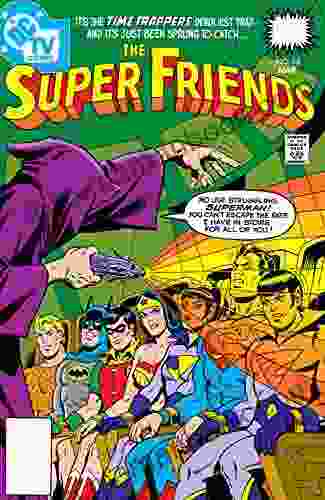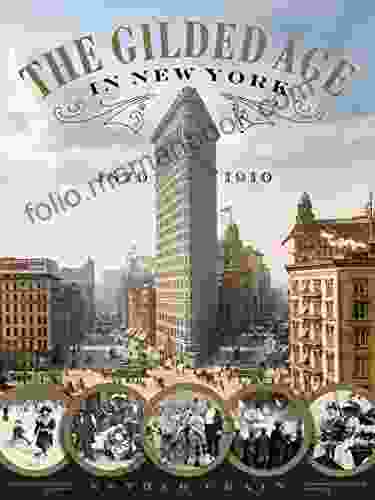The Gilded Age in New York City: A Booming Metropolis and a Time of Great Change (1870-1910)

The Gilded Age was a period of great economic growth and social change in the United States. It began in the 1870s and lasted until the early 1900s. During this time, the country's population exploded, and new industries and technologies emerged. The United States became a global center of commerce and culture, and its cities grew rapidly.
4.7 out of 5
| Language | : | English |
| File size | : | 99798 KB |
| Text-to-Speech | : | Enabled |
| Screen Reader | : | Supported |
| Enhanced typesetting | : | Enabled |
| Word Wise | : | Enabled |
| Print length | : | 295 pages |
New York City was at the heart of the Gilded Age. The city's population grew from 942,292 in 1870 to 4,766,883 in 1910. This growth was due in part to the arrival of millions of immigrants from Europe. The city became a melting pot of cultures, and its neighborhoods reflected the diversity of its population.
The Gilded Age was a time of great economic growth in New York City. The city's industries boomed, and new technologies emerged. The city became a global center of finance and commerce, and its skyline was transformed by the construction of skyscrapers.
The Gilded Age was also a time of great inequality. The gap between the rich and the poor widened, and the city became increasingly segregated. The wealthy lived in luxurious mansions on Fifth Avenue, while the poor lived in crowded tenements in the slums.
The Gilded Age came to an end with the outbreak of World War I. The war disrupted the global economy and led to a decline in immigration. The city's population began to decline, and its economy slowed down.
The Gilded Age was a complex and contradictory period in New York City's history. It was a time of great economic growth and social change, but it was also a time of great inequality. The city's legacy from the Gilded Age is still visible today in its architecture, its neighborhoods, and its diverse population.
The Economic Boom
The Gilded Age was a time of great economic growth in New York City. The city's industries boomed, and new technologies emerged. The city became a global center of finance and commerce, and its skyline was transformed by the construction of skyscrapers.
One of the most important industries in New York City during the Gilded Age was manufacturing. The city was home to a wide variety of factories, which produced everything from clothing to machinery. The city's factories were powered by steam engines, and they employed thousands of workers.
Another important industry in New York City during the Gilded Age was finance. The city was home to the New York Stock Exchange, and it became a global center of finance. The city's banks and investment firms played a major role in the development of the American economy.
The Gilded Age also saw the emergence of new technologies. The telephone, the electric light, and the automobile were all invented during this period. These new technologies transformed the way people lived and worked, and they helped to make New York City a global center of commerce and culture.
The Social Changes
The Gilded Age was also a time of great social change in New York City. The city's population exploded, and new immigrants arrived from all over the world. The city became a melting pot of cultures, and its neighborhoods reflected the diversity of its population.
One of the most important social changes during the Gilded Age was the rise of the middle class. The middle class grew in size and wealth, and it began to play a more important role in society. The middle class lived in modest homes in the city's suburbs, and they worked in a variety of professions.
Another important social change during the Gilded Age was the decline of the aristocracy. The old aristocracy, which had been based on land ownership, began to lose its power and influence. The new aristocracy was based on wealth, and it was made up of industrialists, financiers, and other wealthy individuals.
The Gilded Age also saw the rise of new social movements. The labor movement grew in strength, and it fought for better wages and working conditions. The women's suffrage movement also gained momentum, and it fought for the right of women to vote.
The Legacy of the Gilded Age
The Gilded Age was a complex and contradictory period in New York City's history. It was a time of great economic growth and social change, but it was also a time of great inequality. The city's legacy from the Gilded Age is still visible today in its architecture, its neighborhoods, and its diverse population.
One of the most important legacies of the Gilded Age is the city's architecture. The Gilded Age saw the construction of some of the city's most iconic buildings, including the Empire State Building, the Chrysler Building, and the Grand Central Terminal. These buildings are still symbols of the city's wealth and power, and they continue to attract visitors from all over the world.
Another important legacy of the Gilded Age is the city's neighborhoods. The Gilded Age saw the development of some of the city's most distinctive neighborhoods, including Greenwich Village, Harlem, and the Upper West Side. These neighborhoods are still home to a diverse mix of people, and they reflect the city's rich history.
The Gilded Age also left a legacy of inequality. The gap between the rich and the poor widened during this period, and the city became increasingly segregated. The wealthy lived in luxurious mansions on Fifth Avenue, while the poor lived in crowded tenements in the slums. This inequality is still visible today, and it continues to be a challenge for the city.
The Gilded Age was a time of great change in New York City. The city's population exploded, its economy boomed, and its social structure changed dramatically. The city's legacy from the Gilded Age is still visible today, and it continues to shape the city's character.
4.7 out of 5
| Language | : | English |
| File size | : | 99798 KB |
| Text-to-Speech | : | Enabled |
| Screen Reader | : | Supported |
| Enhanced typesetting | : | Enabled |
| Word Wise | : | Enabled |
| Print length | : | 295 pages |
Do you want to contribute by writing guest posts on this blog?
Please contact us and send us a resume of previous articles that you have written.
 Top Book
Top Book Novel
Novel Fiction
Fiction Nonfiction
Nonfiction Literature
Literature Paperback
Paperback Hardcover
Hardcover E-book
E-book Audiobook
Audiobook Bestseller
Bestseller Classic
Classic Mystery
Mystery Thriller
Thriller Romance
Romance Fantasy
Fantasy Science Fiction
Science Fiction Biography
Biography Memoir
Memoir Autobiography
Autobiography Poetry
Poetry Drama
Drama Historical Fiction
Historical Fiction Self-help
Self-help Young Adult
Young Adult Childrens Books
Childrens Books Graphic Novel
Graphic Novel Anthology
Anthology Series
Series Encyclopedia
Encyclopedia Reference
Reference Guidebook
Guidebook Textbook
Textbook Workbook
Workbook Journal
Journal Diary
Diary Manuscript
Manuscript Folio
Folio Pulp Fiction
Pulp Fiction Short Stories
Short Stories Fairy Tales
Fairy Tales Fables
Fables Mythology
Mythology Philosophy
Philosophy Religion
Religion Spirituality
Spirituality Essays
Essays Critique
Critique Commentary
Commentary Glossary
Glossary Bibliography
Bibliography Index
Index Table of Contents
Table of Contents Preface
Preface Introduction
Introduction Foreword
Foreword Afterword
Afterword Appendices
Appendices Annotations
Annotations Footnotes
Footnotes Epilogue
Epilogue Prologue
Prologue Angela Magara
Angela Magara Apryl Cox
Apryl Cox Laura Andersen
Laura Andersen Julia Indichova
Julia Indichova Jeffrey S Lantis
Jeffrey S Lantis Elaine Hall
Elaine Hall Ike Hamill
Ike Hamill David Snodin
David Snodin Mike C
Mike C Tim Cooper
Tim Cooper William Shakespeare
William Shakespeare Saurabh Mukherjea
Saurabh Mukherjea Lavee Natch
Lavee Natch Alan Dean Foster
Alan Dean Foster Margaret Maron
Margaret Maron Robyn Conrad Hansen
Robyn Conrad Hansen Victoria Waller
Victoria Waller Alta H Mabin
Alta H Mabin Kathleen Weber
Kathleen Weber Subhash Chandra
Subhash Chandra
Light bulbAdvertise smarter! Our strategic ad space ensures maximum exposure. Reserve your spot today!

 Dylan MitchellSuper Friends: The Animated Adventures That Defined a Generation (1976-1981)
Dylan MitchellSuper Friends: The Animated Adventures That Defined a Generation (1976-1981) Bret MitchellFollow ·10.4k
Bret MitchellFollow ·10.4k Christopher WoodsFollow ·3.6k
Christopher WoodsFollow ·3.6k Mikhail BulgakovFollow ·4.3k
Mikhail BulgakovFollow ·4.3k Gary ReedFollow ·7k
Gary ReedFollow ·7k Deion SimmonsFollow ·8.6k
Deion SimmonsFollow ·8.6k Ismael HayesFollow ·9k
Ismael HayesFollow ·9k Darius CoxFollow ·14.3k
Darius CoxFollow ·14.3k Isaias BlairFollow ·11.6k
Isaias BlairFollow ·11.6k

 Dean Cox
Dean CoxHow to Make Decisions Easily & Effortlessly: The...
The Different Types of Decisions There...

 Gustavo Cox
Gustavo CoxThe End of World War II and the Birth of Baseball's...
The end of...

 Patrick Rothfuss
Patrick RothfussThe Dantes: An 11-Family Saga of Billionaires, Soulmates,...
The Dantes is an epic family saga that follows...

 Dylan Mitchell
Dylan MitchellSuper Friends: The Animated Adventures That Defined a...
In the vibrant landscape of American...

 Jamal Blair
Jamal BlairCollege For Students With Disabilities: We Do Belong
College can be a...
4.7 out of 5
| Language | : | English |
| File size | : | 99798 KB |
| Text-to-Speech | : | Enabled |
| Screen Reader | : | Supported |
| Enhanced typesetting | : | Enabled |
| Word Wise | : | Enabled |
| Print length | : | 295 pages |












